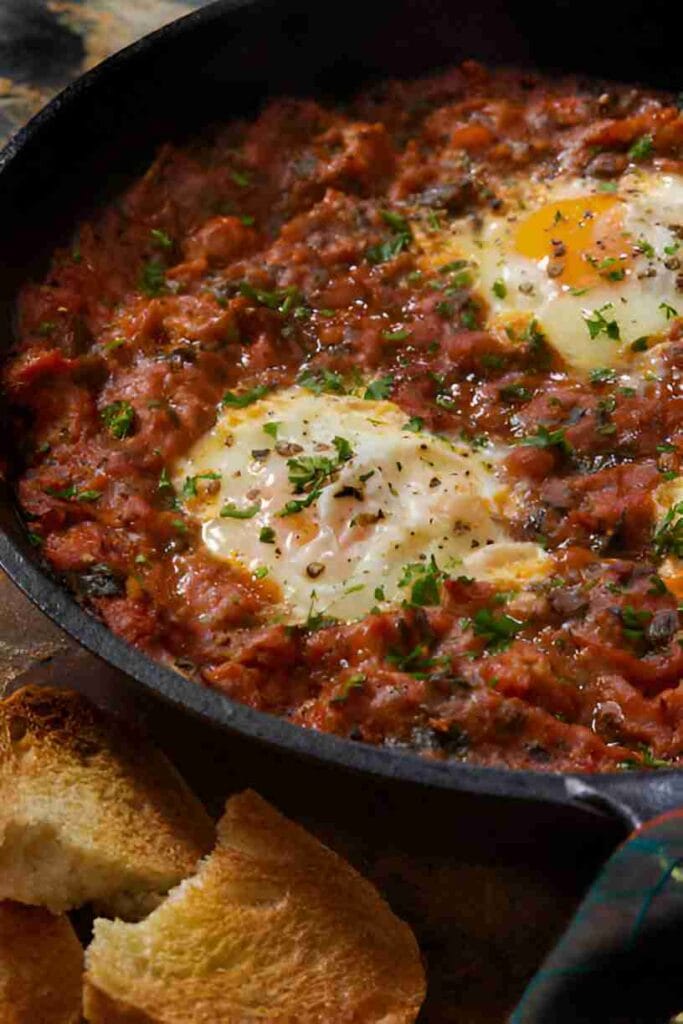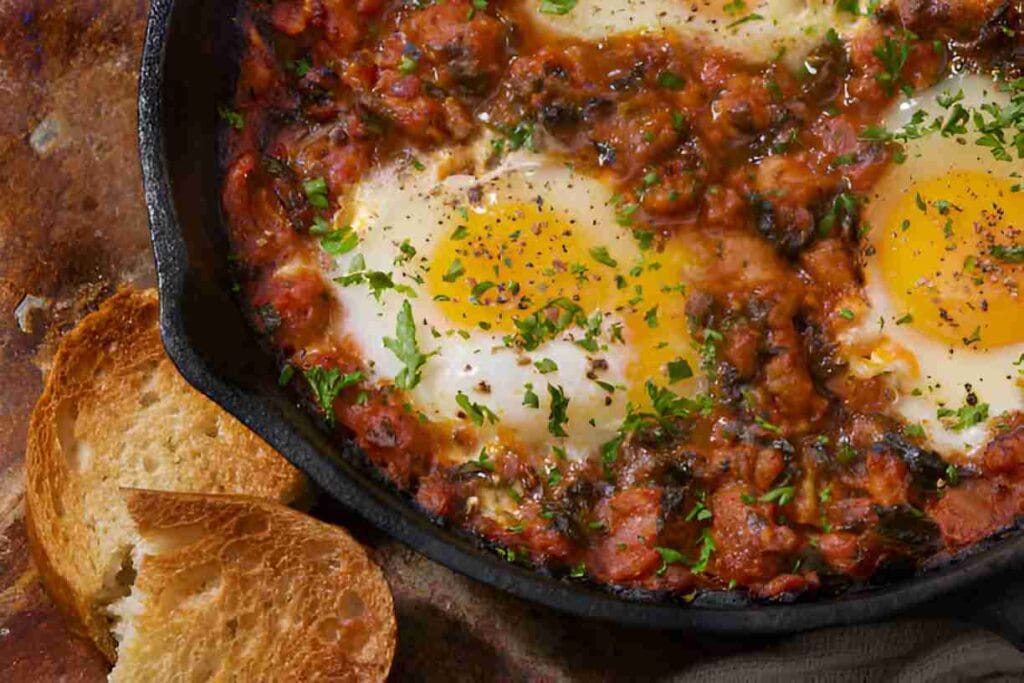Eggs in Purgatory is a culinary delight that has captured the hearts and taste buds of many. With its rich flavors and comforting ingredients, this Mediterranean-inspired meal is perfect for breakfast, brunch, lunch, or even dinner! Let’s dive into why you’ll love making this dish, the essential ingredients you’ll need, and how to prepare it step by step.

Table of Contents
Why You’ll Love Eggs in Purgatory
Perfect for Families
Eggs in Purgatory is not just a meal; it’s an experience! Preparing this dish together can be a fun family activity, making it perfect for weekend brunches. The vibrant colors and tantalizing aromas make it attractive to kids and adults alike, ensuring that everyone around the table has a smile on their faces. Plus, it’s a hearty dish that can keep hunger at bay without much fuss, allowing families to come together and enjoy quality time.
Nutritional Benefits
This dish is not only delicious but also packed with nutrients! The primary ingredients, like eggs and vegetables, contribute to a balanced diet rich in protein, vitamins, and minerals. The tomatoes in the sauce are also full of antioxidants, particularly lycopene, which is good for heart health. With just a handful of simple ingredients, you can whip up a meal that’s both wholesome and satisfying.
Flexibility
Eggs in Purgatory shine when it comes to flexibility. Whether you’re on a strict budget, have dietary restrictions, or want to use up what’s in your fridge, this dish can easily adapt to fit your needs. You can add in whatever vegetables you have on hand, adjust the spice level to suit your family’s tastes, and even make it vegetarian if you prefer.
Essential Ingredients for the Recipe
Ingredients:
- 2 tbsp olive oil
- 3 garlic cloves, sliced
- ½ tsp red pepper flakes (adjust to taste)
- 1 can (28 oz) crushed tomatoes
- 1 tsp dried oregano
- 4 large eggs
- ¼ cup grated Pecorino Romano
- Fresh basil leaves
- Salt and black pepper to taste
Olive Oil: A Flavorful Base
Olive oil plays a crucial role in this dish, serving as the cooking fat that adds rich flavor and helps sauté the vegetables. It’s also packed with heart-healthy fats! If you’re out of olive oil, you can substitute it with avocado oil or even coconut oil, but keep in mind that the flavor will slightly change.
Tomatoes: The Heart of the Dish
Canned chopped tomatoes bring both sweetness and acidity to the dish. Fresh tomatoes work too if you prefer, but to simplify your cooking experience, canned versions save time and energy. Just ensure you choose high-quality tomatoes for the best flavor.
Eggs: The Star Ingredient
Eggs are the star of the show, providing protein and making this dish filling. You can use whole eggs, or if you’re looking for a lighter option, egg whites work well but may require a slight adjustment in cooking time.
Ingredient Preparation
Step 1 – Sautéing the Base
Begin by heating the olive oil in a large skillet over medium heat. Add the sliced onion and red bell pepper to the pan, sautéing them until they become soft and translucent—about 3-5 minutes. This step builds the base flavor of your dish, so take the time to let these cook through.
Step 2 – Adding Aromatics
Next, add the minced garlic and a pinch of red pepper flakes to the mixture. Cook for an additional minute until the garlic becomes fragrant and golden. Be careful not to let it burn, as burnt garlic can impart bitter flavors to your dish.
Step 3 – Mixing in Tomatoes
Pour in your canned chopped tomatoes, and stir everything together. Season with salt and pepper, and add the chiffonade of fresh basil. Turn the heat to medium-low and simmer the mixture for about 20 minutes, allowing all of those delicious flavors to meld together. Feel free to squish the tomatoes with a wooden spoon to create a rich sauce.
Step-by-Step Cooking Instructions
Step 1 – Prepare Your Cooking Space
Before you begin, make sure all your ingredients are chopped and ready to go. A well-organized cooking space makes for a smooth cooking experience.
Step 2 – Assemble the Ingredients
Once the sauce has simmered and the flavors have merged, it’s time to create divots in the sauce to hold the eggs. Using a spoon, carefully make about six small divots in the sauce.
Step 3 – Cook the Eggs
Crack an egg into each divot gently, cover the skillet, and let them cook until the whites are set but the yolks are still runny—this should take around 2-3 minutes. Remove from heat and garnish with minced parsley for a fresh finish.
Tips for an Even Tastier Version
Adding Extra Ingredients
To enhance the flavor and texture, consider adding more vegetables like spinach, zucchini, or mushrooms to your sauce. You can also sprinkle in some feta cheese or goat cheese for extra creaminess and tang.
Techniques to Enhance Flavor
For an additional kick, try marinating your vegetables in lemon juice or adding a splash of balsamic vinegar. Using fresh herbs like thyme or oregano can also elevate the dish in a delightful way.
Adjustments for Preferences
If you’re cooking for a special diet, feel free to substitute ingredients. For example, use low-sodium canned tomatoes, or if you’re vegan, try tofu scramble in place of eggs, cooking it until golden brown.
Recipe Variations and Adaptations
Vegetarian Option
Eggs in Purgatory are inherently vegetarian, but if you want to bulk it up, consider adding lentils or chickpeas to the sauce for extra protein and fiber.
Gluten-Free or Low-Carb Option
Serve the eggs over a bed of wilted spinach or zucchini noodles instead of bread for a gluten-free or low-carb option that maintains all of the delightful flavors.
Other Adaptations
Feel free to switch up the flavors based on the seasons. During autumn, adding pumpkin puree can provide a warm, comforting taste, while in spring, fresh asparagus can add a delightful crunch.
Serving Suggestions
Salad or Soup Ideas
Pair this dish with a light arugula salad dressed in lemon vinaigrette or a refreshing cucumber soup. The brightness of these flavors will beautifully complement the richness of the eggs in Purgatory.
Hearty Sides
For those who are looking for something more substantial, serve this with homemade crusty bread, roasted sweet potatoes, or a side of sautéed kale to round out the meal.
Drink Recommendations
Enjoy your creation with a glass of crisp white wine or a refreshing glass of iced tea. For a non-alcoholic option, consider serving some homemade lemonade or sparkling water with slices of lime.

Storage and Reheating Tips
How to Store Leftovers
If you have any leftovers, store them in an airtight container in the fridge for up to three days. Just be mindful that the texture of the eggs may change slightly after reheating.
Reheating Techniques
To reheat, you can use the microwave for convenience or warm it gently on the stovetop. Avoid cooking too long, as this could lead to rubbery eggs.
Portioning Tips
This recipe is ideal for meal prep. You can portion out individual servings in advance to make enjoying this delightful dish during the busy week even more straightforward.
Nutritional Information and Benefits
Nutritional Values per Serving
One serving of Eggs in Purgatory typically contains about 280 calories, boasting a good balance of protein (around 14g), fiber, and essential vitamins.
- Serving Size: 1 egg + ½ cup sauce
- Calories: 280
- Sugar: 8g
- Sodium: 420mg
- Fat: 18g
- Saturated Fat: 4.5g
- Unsaturated Fat: 12g
- Trans Fat: 0g
- Carbohydrates: 15g
- Fiber: 3g
- Protein: 14g
- Cholesterol: 190mg
Ingredient Benefits
The eggs provide a fantastic source of high-quality protein, while the tomatoes are rich in vitamin C and antioxidants. Olive oil contributes healthy fats, making this dish both balanced and nourishing.
Recommended Portions
A typical serving would be 1-2 eggs with sauce, depending on your appetite. Pair it with a slice of bread if you need something more hearty.
Common Mistakes to Avoid
Overcooking the Eggs
One common mistake is overcooking the eggs. Watch them closely to ensure they don’t become rubbery. You want the whites set, but the yolks are still slightly runny.
Not Seasoning Properly
Failing to season your dish adequately can lead to a bland experience. Don’t skimp on salt and pepper during the cooking process.
Ignoring Texture
Ensure you allow the sauce to simmer appropriately to develop a rich texture. Undercooked tomatoes can lead to a watery dish that doesn’t match your expectations.
Inspiring Conclusion
Eggs in Purgatory is not just a dish; it’s an invitation to gather around the table with loved ones, share delicious food, and create lasting memories. The warmth of the sauce and the richness of the eggs make every bite comforting and satisfying. I encourage you to experiment with this recipe, make it your own, and enjoy the joy of cooking and sharing meals with family and friends. Don’t hesitate to share your creations and let this wonderful meal become a cherished tradition in your home.
FAQ (Frequently Asked Questions)
- Can I prepare this recipe in advance? Yes, you can prepare the tomato sauce in advance and store it in the fridge. Just cook the eggs fresh when ready to serve.
- What are the best substitutes for olive oil? Avocado oil or coconut oil can be suitable substitutes if you don’t have olive oil on hand.
- Can I use fresh tomatoes instead of canned? Absolutely! Just ensure to peel and chop them, adjusting the cooking time as fresh tomatoes may release more liquid.
- How can I make this dish spicier? You can add more red pepper flakes or a splash of hot sauce to the tomato sauce for a spicy kick.
- What’s the best way to store leftovers? Store leftovers in an airtight container in the fridge for up to three days.
- Can I freeze Eggs in Purgatory? While you can freeze the sauce, it’s recommended to reheat eggs freshly cooked for the best texture.
- Is this dish suitable for vegetarians? Yes, Eggs in Purgatory is a vegetarian-friendly dish.
- Can I add cheese to this recipe? Yes! Cheese like feta or mozzarella can add a creamy layer that complements the eggs beautifully.
- What type of bread pairs well with this dish? Crusty bread, sourdough, or even a simple baguette works wonderfully for scooping up the sauce.
- How can I make this dish gluten-free? Serve the eggs over greens, such as spinach, or zoodles instead of bread for a gluten-free option.
Chickpea Shakshuka: A Delicious, Nutritious Recipe You Need to Try

Eggs in Purgatory
Ingredients
- 2 tbsp olive oil
- 3 garlic cloves, sliced
- ½ tsp red pepper flakes (adjust to taste)
- 1 can (28 oz) crushed tomatoes
- 1 tsp dried oregano
- 4 large eggs
- ¼ cup grated Pecorino Romano
- Fresh basil leaves
- Salt and black pepper to taste
Instructions
- Heat oil in large skillet over medium. Sauté garlic and pepper flakes 1 minute until fragrant.Add tomatoes and oregano. Simmer 10 minutes until thickened. Season with salt.Create 4 wells in sauce. Crack eggs into wells.Cover and cook 5-7 minutes until whites set but yolks remain runny.Sprinkle with cheese and basil. Serve immediately with bread.
Notes
- For richer sauce, add 1 tbsp tomato paste with garlic
- Substitute feta for Pecorino for different flavor profile

